The Microstructure and Property of a Titanium-Carbon Steel Clad Plate Prepared Using Explosive Welding
Abstract
:1. Introduction
2. Experimental Procedure
2.1. Materials
2.2. Explosive Welding Process
2.3. Specimen Characterization
3. Results and Discussion
4. Conclusions
- (1)
- After explosive welding, the Ti and carbon steel were successfully joined together. The image using the ultrasonic C-scanning imaging technology shows the interface waves are uniform and there are no defects at the bounding interface. The optical and SEM observations show that the typical wavy interface has formed with no visible defects. No Fe or Ti element diffusion is found across the interface by EDS analyses.
- (2)
- After heat treatment, the hardness values at the titanium layer of the clad plate are similar to that of the original Ti material, whereas the hardness values at the carbon steel layer increase from the bonding interface to 300 μm away.
- (3)
- The results of shearing and tensile tests show that the mechanical properties of the clad plate meet the requirements of ASTM B898 standard.
- (4)
- Corrosion results show that the Ecorr absolute value of the clad plate increases about 20%, and the icorr value is 1 order of magnitude lower, compared with carbon steel material. It indicates that the corrosion resistance of the clad plate is better than carbon steel material. Compared with original Ti material, the corrosion resistance of titanium side in clad plate decreases.
Funding
Institutional Review Board Statement
Informed Consent Statement
Data Availability Statement
Acknowledgments
Conflicts of Interest
References
- MacDonald, D.E.; Markovic, B.; Allen, M.; Somasundaran, P.; Boskey, A.L. Surface analysis of human plasma fibronectin adsorbed to commercially pure titanium materials. J. Biomed. Mater. Res. 2015, 41, 120–130. [Google Scholar] [CrossRef]
- Li, X.D.; Qiu, C.Y.; Liu, Y.T.; Wang, H.F.; Zheng, D.D.; Zhu, Y.Y.; Zhang, S.Q. Effect of thermal deformation on microstructure and properties of TC18 titanium alloy produced by laser additive manufacturing. J. Iron Steel Res. Int. 2020, 27, 1476–1484. [Google Scholar] [CrossRef]
- Chen, Z.X.; Hu, H.X.; Guo, X.M.; Zheng, Y.G. Effect of groove depth on the slurry erosion of V-shaped grooved surfaces. Wear 2022, 488–489, 204133. [Google Scholar] [CrossRef]
- Zu, G.Y.; Sun, X.; Zhang, J.H. Interfacial Bonding Mechanism and Mechanical Performance of Ti/Steel Bimetallic Clad Sheet Produced by Explosive Welding and Annealing. Rare Metal Mater. Eng. 2017, 46, 906–911. [Google Scholar]
- Song, Q.N.; Tong, Y.; Li, H.L.; Zhang, H.N.; Xu, N.; Zhang, G.Y.; Bao, Y.F.; Liu, W.; Liu, Z.G.; Qiao, Y.X. Corrosion and cavitation erosion resistance enhancement of cast Ni-Al bronze by laser surface melting. J. Iron Steel Res. Int. 2021. [Google Scholar] [CrossRef]
- Zhang, L.M.; Li, Z.X.; Hu, J.X.; Ma, A.L.; Zhang, S.; Daniel, E.F.; Umoh, A.J.; Hu, H.X.; Zheng, Y.G. Understanding the roles of deformation-induced martensite of 304 stainless steel in different stages of cavitation erosion. Tribol. Int. 2021, 155, 106752. [Google Scholar] [CrossRef]
- Zhao, H. Characterization of the microstructure and bonding properties of zirconium-carbon steel clad materials by explosive welding. Scanning 2020, 2020, 8881898. [Google Scholar] [CrossRef]
- Li, S.Y.; Li, Q.S.; Chen, Z.G.; Wen, J.X. Microstructure and Mechanical Properties of Explosively Welded R60702/TA2 Composite Plate. Rare Metal Mater. Eng. 2019, 48, 1734–1741. [Google Scholar]
- Zhao, H.; Sheng, L.Y. Microstructure and mechanical properties of the Ag/316L composite plate fabricated by explosive welding. J. Manuf. Process. 2021, 64, 265–275. [Google Scholar] [CrossRef]
- Kaya, Y.; Eser, G. Production of ship steel-titanium bimetallic compositions through explosive welding. Weld World 2019, 63, 1547–1560. [Google Scholar] [CrossRef]
- Jiang, H.T.; Yan, X.Q.; Liu, J.X.; Duan, X.G. Effect of heat treatment on microstructure and mechanical property of Ti–steel explosive-rolling clad plate. Trans. Nonferrous Met. Soc. China 2014, 24, 697–704. [Google Scholar] [CrossRef]
- Akbari, S.A.A.; Sartangi, P.F. Effect of post-weld heat treatment on the interface microstructure of explosively welded titanium-stainless steel composite. Mater. Sci. Eng. A 2018, 119, 469–475. [Google Scholar] [CrossRef]
- Lazurenkoa, D.V.; Bataeva, I.A.; Malib, V.I. Structural Transformations Occurring upon Explosive Welding of Alloy Steel and High-Strength Titanium. Surf. Phase Transform. Diffus. 2018, 119, 469–476. [Google Scholar] [CrossRef]
- Wu, J.Q.; Wang, W.X.; Cao, X.Q.; Nan, Z. Interface Bonding Mechanism and Mechanical Behavior of AZ31B/TA2 Composite Plate Cladded by Explosive Welding. Rare Metal Mater. Eng. 2017, 46, 640–645. [Google Scholar]
- Zhao, H.; Zhu, L.; Li, P.C.; Zhang, J.Y.; Shen, C.Y.; Li, Y.; Hao, H.W.; Zhao, F.; Feng, H.L.; Gao, J.F. A Method for Dynamic Parameters of Metal Plate Explosive Welding. China Patent CN201610137182.6, 21 November 2017. [Google Scholar]
- Pouraliakbar, H.; Khalaj, G.; Jandaghi, M.R.; Fadaei, A.; Ghareh-Shiran, M.K.; Shim, S.H.; Hong, S.I. Three-layered SS321/AA1050/AA5083 explosive welds: Effect of PWHT on the interface evolution and its mechanical strength. Int. J. Press. Vessel. Pip. 2020, 188, 104216. [Google Scholar] [CrossRef]
- Shiran, M.R.; Bakhtiari, H.; Mousavi, S.A.; Khalaj, G.; Mirhashemi, S.M. Effect of Stand-Off Distance on the Mechanical and Metallurgical Properties of Explosively Bonded 321 Austenitic Stainless Steel-1230 Aluminum Alloy Tubes. Mater. Res. 2017, 20, 291–302. [Google Scholar] [CrossRef] [Green Version]
- ASTM Standards B898-09[S]; Standard Specification for Reactive and Refractory Metal Clad Plate. ASTM International: West Conshohocken, PA, USA, 2016.
- Khanzadeh, M.R.; Akbari Mousavi, S.A.; Amadeh, A.; Liaghat, G.H. Correlation between numerical finite element simulation and experiments for explosive cladding of nikel base super alloy on hot tool steel. Strain 2012, 48, 342–355. [Google Scholar] [CrossRef]
- Wilson Dhileep Kuma, C.; Saravanan, S.; Raghukandan, K. Influence of grooved base plate on microstructue and mechanical strength of aluminum-stainless steel explosive cladding. Metall. Mater. Eng. 2019, 72, 3269–3276. [Google Scholar]
- Zhang, H.; Jiao, K.X.; Zhang, J.L.; Liu, J. Microstructure and mechanical properties investigations of copper-steel composite fabricated by explosive welding. Mater. Sci. Eng. A 2018, 731, 278–287. [Google Scholar] [CrossRef]
- SVg, A.; Svk, A.; Sns, B. Microstructure and mechanical properties of sandwich copper/steel composites produced by explosive welding. Mater. Charact. 2019, 154, 294–303. [Google Scholar]
- Qiao, Y.; Wang, X.; Yang, L.; Wang, X.; Chen, J.; Wang, Z.; Zhou, H.; Zou, J.; Wang, F. Effect of aging treatment on microstructure and corrosion behavior of a Fe–18Cr–15Mn–0.66N stainless steel. J. Mater. Sci. Technol. 2022, 107, 197–206. [Google Scholar] [CrossRef]


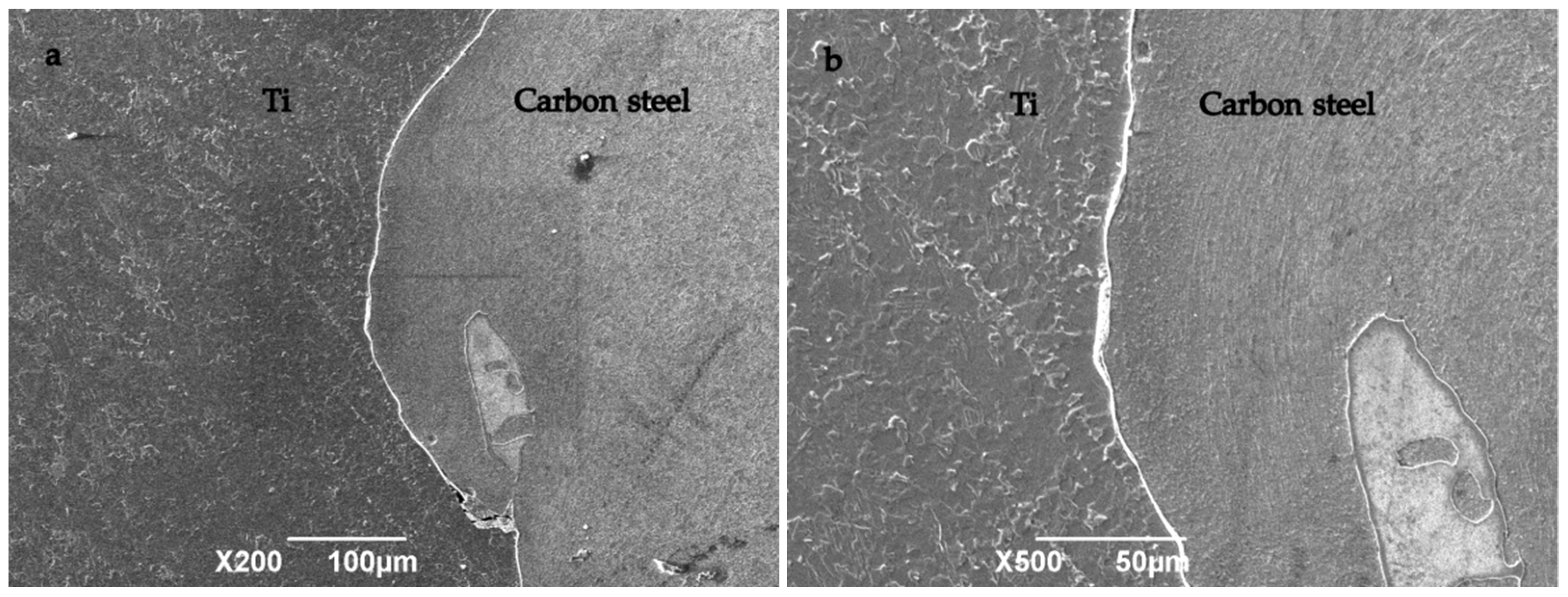
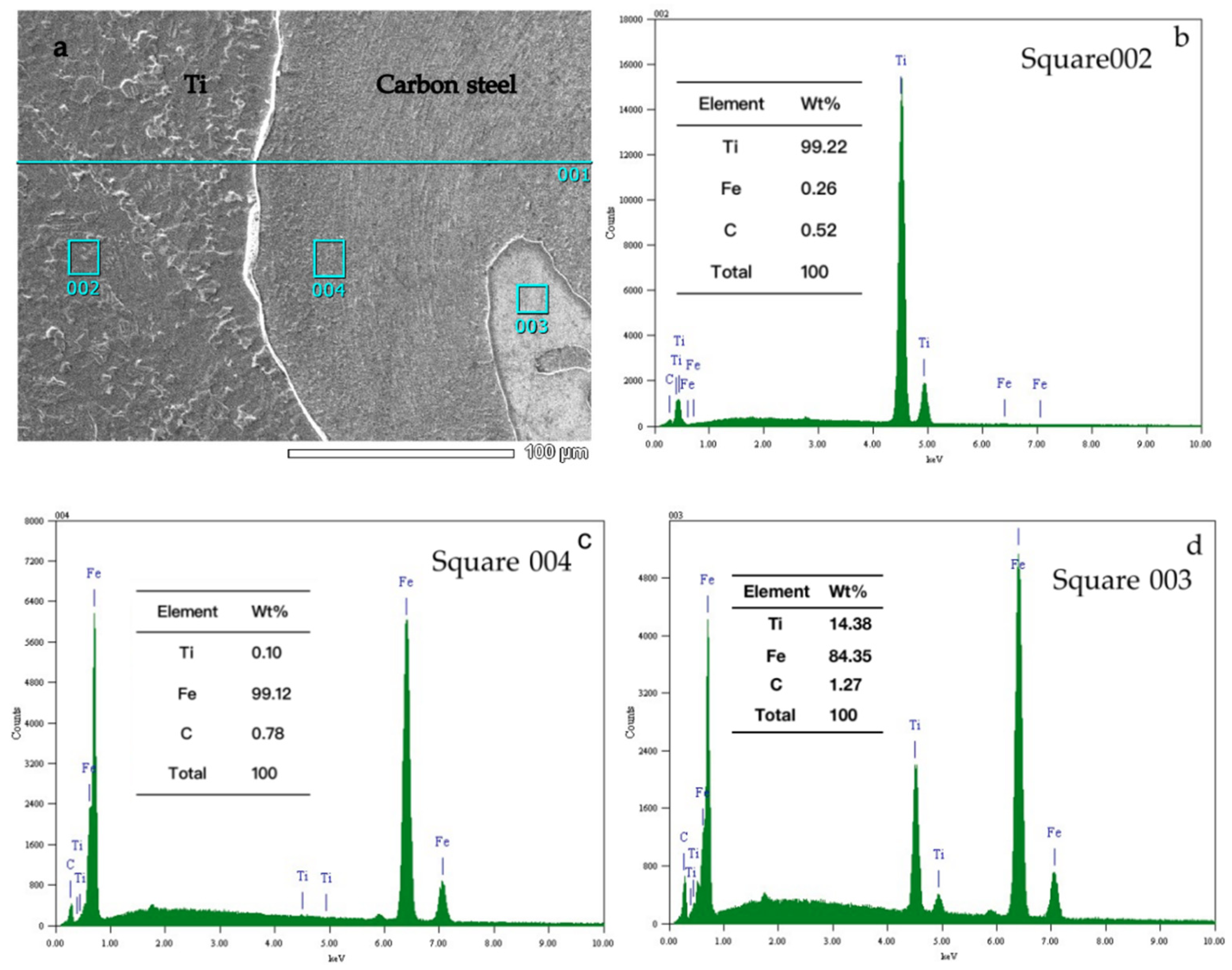
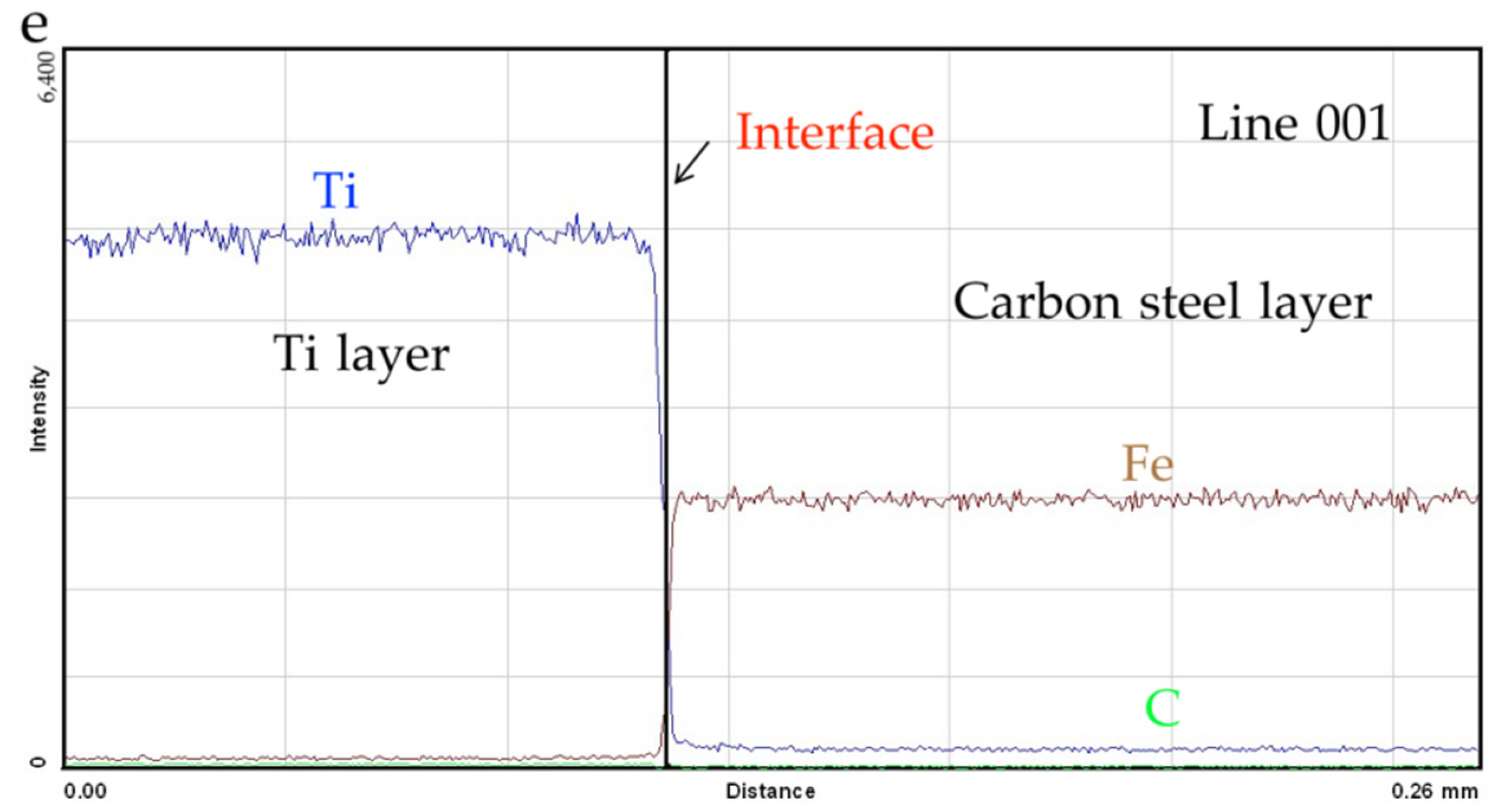
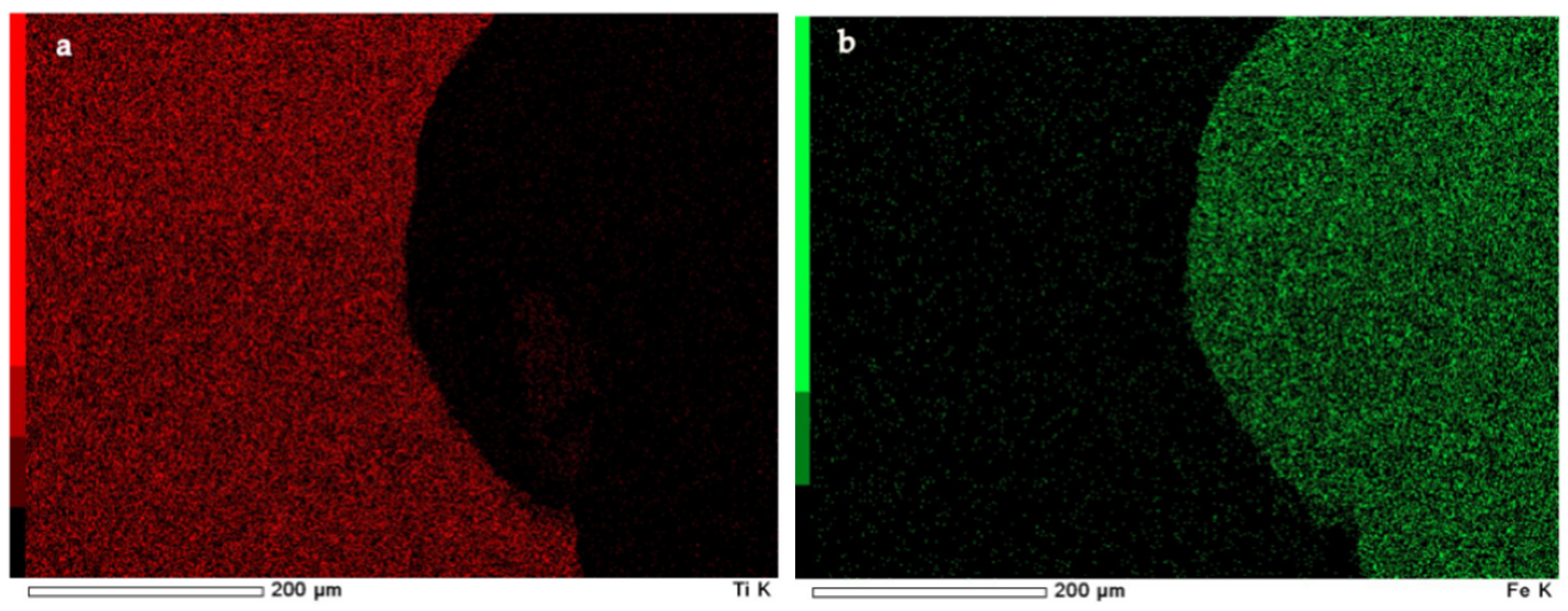
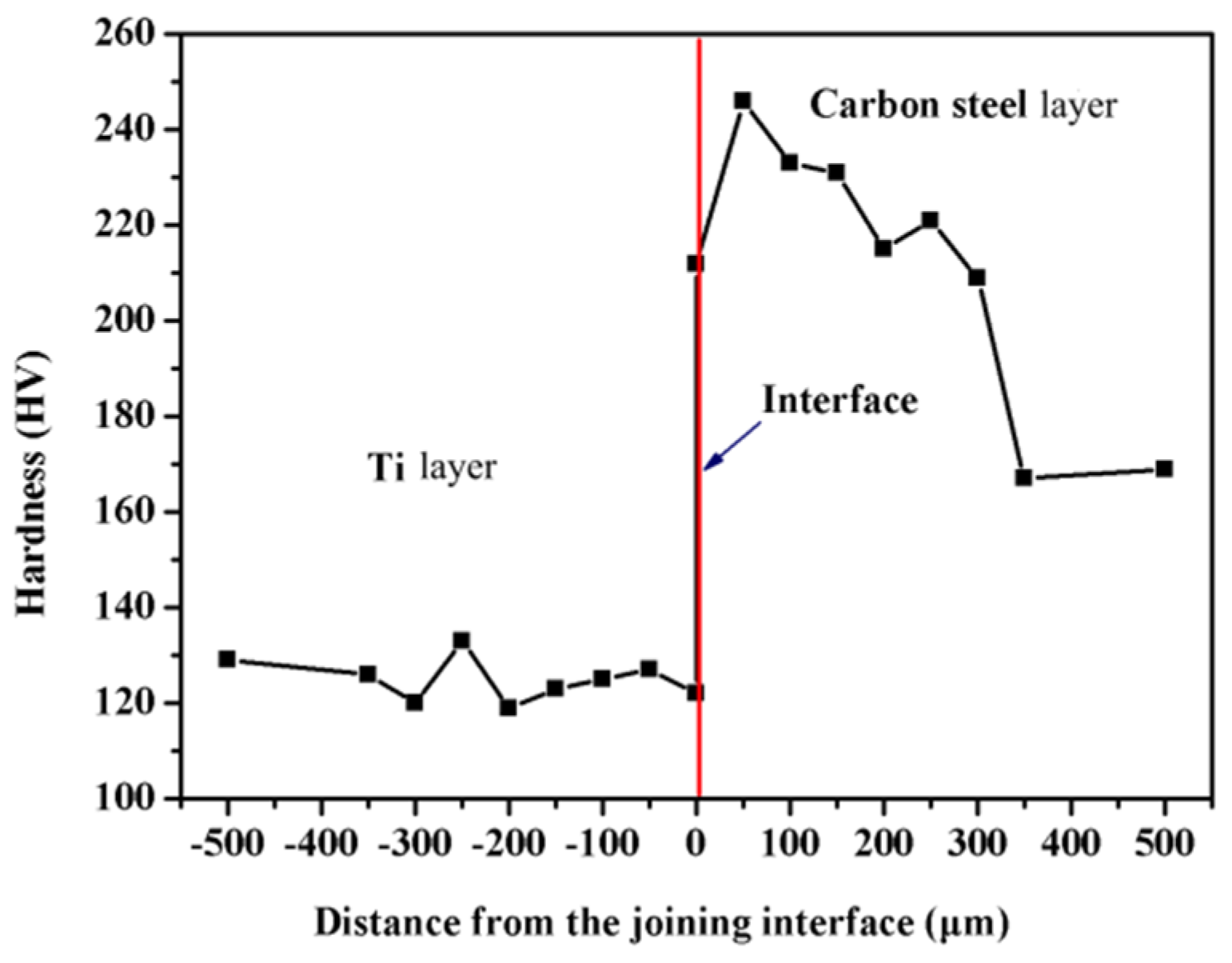
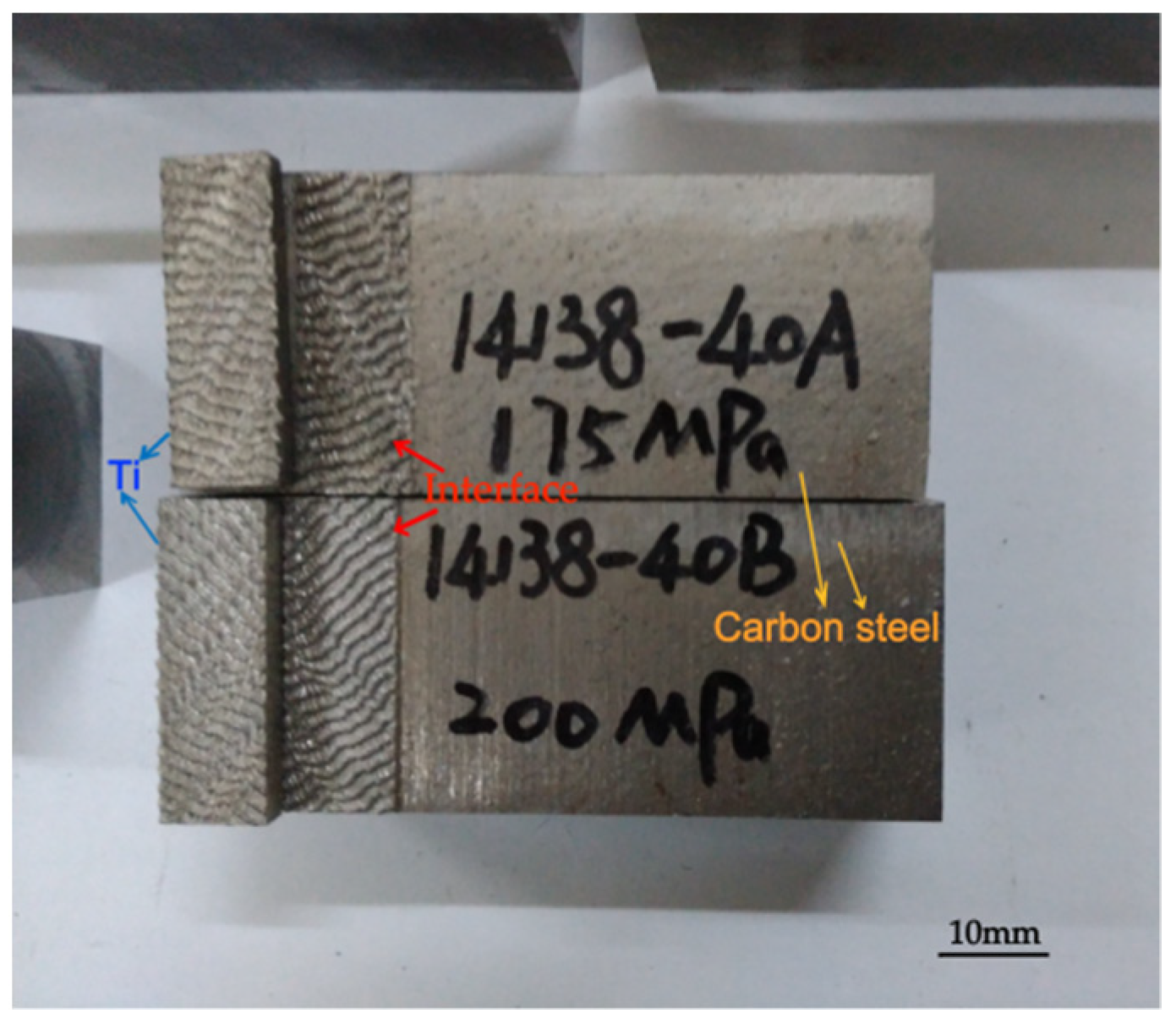
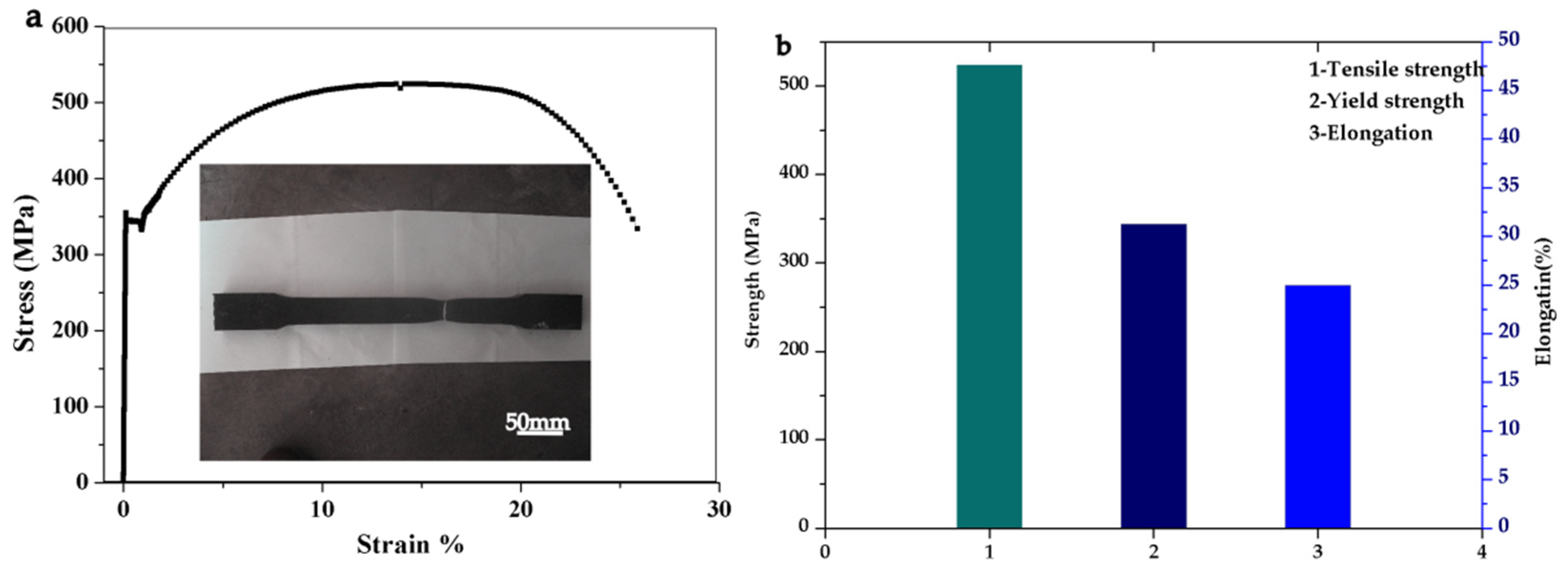
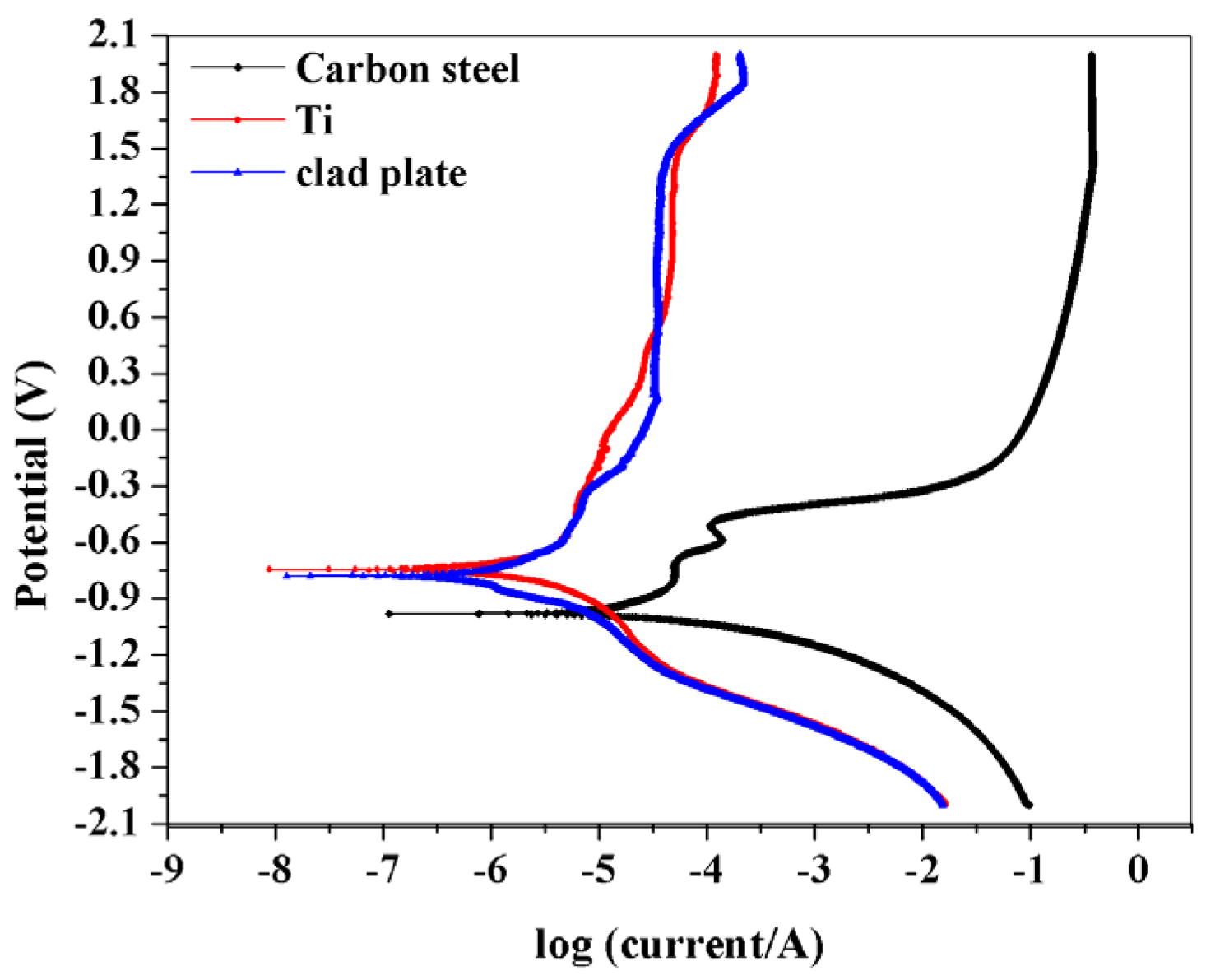
| Materials | Chemical Element | |||||
|---|---|---|---|---|---|---|
| Ti | C | H | N | O | Fe | Ti |
| 0.07 | 0.010 | 0.02 | 0.17 | 0.01 | Bal. | |
| Carbon steel | C | Mn | Si | P | S | C |
| 0.18 | 1.04 | 0.28 | ≤0.003 | ≤0.003 | 0.18 | |
| Materials | Ecorr. (mV) | icorr. (A/cm2) |
|---|---|---|
| Carbon steel | −977.6 | 1.13 × 10−7 |
| Original titanium material | −746.7 | 8.79 × 10−9 |
| Clad plate | −782.4 | 2.11 × 10−8 |
Publisher’s Note: MDPI stays neutral with regard to jurisdictional claims in published maps and institutional affiliations. |
© 2022 by the author. Licensee MDPI, Basel, Switzerland. This article is an open access article distributed under the terms and conditions of the Creative Commons Attribution (CC BY) license (https://creativecommons.org/licenses/by/4.0/).
Share and Cite
Zhao, H. The Microstructure and Property of a Titanium-Carbon Steel Clad Plate Prepared Using Explosive Welding. Metals 2022, 12, 129. https://doi.org/10.3390/met12010129
Zhao H. The Microstructure and Property of a Titanium-Carbon Steel Clad Plate Prepared Using Explosive Welding. Metals. 2022; 12(1):129. https://doi.org/10.3390/met12010129
Chicago/Turabian StyleZhao, Hui. 2022. "The Microstructure and Property of a Titanium-Carbon Steel Clad Plate Prepared Using Explosive Welding" Metals 12, no. 1: 129. https://doi.org/10.3390/met12010129
APA StyleZhao, H. (2022). The Microstructure and Property of a Titanium-Carbon Steel Clad Plate Prepared Using Explosive Welding. Metals, 12(1), 129. https://doi.org/10.3390/met12010129






